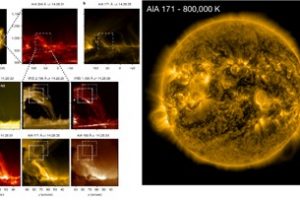A step forward the comprehension of solal corona heating: Observed for the first time coronal nanojets

Solar corona is the outer atmosphere of our star. Extended for several solar radii, it is made of million degrees plasma, thus being hotter than the gas in the photosphere (about 5600 degrees). Several scientist have tried understanding the mechanism responsible for the heating of coronal plasma, but it is has been an open issue for decades. The most promising theory has been proposed in the 80’s by the solar physicist E. N. Parker, who suggested that the corona is heated by the energy released by a myriad of rapid and localized nanoflares.
Flares surely are the most spectacular phenomena occurring in the corona. They are triggered by magnetic reconnection events, which are followed by the release of large amount of energy previously stored in the magnetic field. If we describe the magnetic field using magnetic field lines, these lines are continuously stretched and twisted by the turbulence in the photosphere, where they are anchored. After some time, some of these lines accumulate a large tension, thus they break and connect with other lines, reducing the tension and releasing large amount of energy. In fact, the solar corona is composed by large and bright loops containing plasma at million of degrees. In Parker’s hypothesis, recconnection events occur continuously at small spatial scales, triggering nanoflares which are billion times less energetic than large flares (they still release energy of about 1024 erg, thousand of times the energy released by an atomic bomb), but they are more frequent and short-living, being responsible for the global heating of the corona.
Nanoflares have never been directly observed. This because of the difficulty in resolving such fast and highly localized phenomena occurring in the Sun. However, the team lead by the astronomer Patrick Antolin (Northumbria University) has observed for the first time a phenomenon associated with nanoflares, called nanojets, by analyzing an observation long several hours of a network of large loops formed in the solar limb and reaching a peak elevation of 20000-40000 km. The observations were acquired in the UV band with the instruments Atmospheric Imaging Assembly (AIA) of the Solar Dynamics Observatory (SDO) and the Interface Region Imaging Spectrograph (IRIS). With the term “nanojet” the authors indicate flows of particles accelerated up to a velocity of several km/sec by the energy released by the magnetic reconnection. Nanojets are predicted by the theory of nanoflares and their presence has also been demonstrated by the authors with magneto-hydrodynamic simulations of magnetic reconnections. Thus, they prove unequivocally the presence of nanoflares and their role in heating the coronal plasma. In particular, the observed nanojets last for a few seconds, reaching a width of about 500 km and length of 1000-2000 km. The nanojets were observed in the entire loop, and their frequency increased with the time. At the end of the observations, a total of 150 nanojets were detected, each realising about 1025 erg of energy.
Together with P. Antolin, the authors of this study counts only Sicilian astronomers: prof. Fabio Reale (University of Palermo, INAF – Astronomical Observatory of Palermo) and the researchers Antonino Petralia (INAF – Astronomical Observatory of Palermo), Paolo Pagano (University of St. Andrews), and Paola Testa (Harvard-Smithsonian Center for Astrophysics).
“We can’t see the magnetic field” prof. Reale says “magnetic reconnection is a phenomenon capable of dispersing large amount of magnetic energy into heat, but it is very difficult to observe it since it occurs on very small spatial scales and without evident signatures. We have been working on this phenomenon since several decades, but today we finally have found a smoking gun, e.g. small jets that move away from magnetic loops. How do we know that they are a signature for magnetic reconnection? They have been predicted by theories, and we have setup an MHD simulation that clearly show their emergence during magnetic reconnections. This is the demonstration that the magnetic field heats up the corona by a myriad of small explosions which produce such nanojets”. The study is described in the paper “Reconnection Nanojets in the Solar Corona”, recently appeared on the prestigious journal Nature Astronomy.
The image (click here to visualize the entire figure) shows: In the panel a) the magneto-hydrodynamic simulation of a magnetic reconnection producing nanojets. The magnetic tubes are marked in green and purple, the jets is instead marked in gray, with the direction of expansion marked with arrows; the panel b) shows and IRIS observation of a a nanojet acquired at 1400 Å. The nanojet has a bright head, is about 500 km wide, and it moves at about 240 km/sec.
Mario Giuseppe Guarcello ( follow mguarce)
